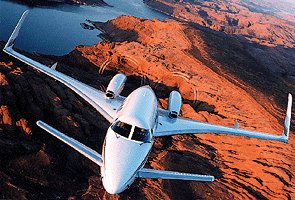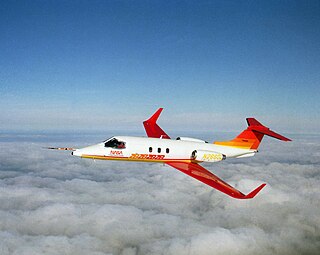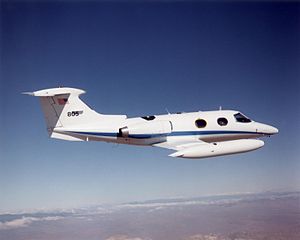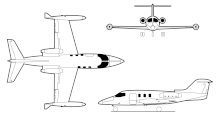
The Convair 880 is a retired American narrow-body jet airliner produced by the Convair division of General Dynamics. It was designed to compete with the Boeing 707 and Douglas DC-8 by being smaller but faster, a niche that failed to create demand. When it was first introduced, some in aviation circles claimed that at 615 mph (990 km/h), it was the fastest jet transport in the world. Only 65 Convair 880s were produced over the lifetime of the production run from 1959 to 1962, and General Dynamics eventually withdrew from the airliner market after considering the 880 project a failure. The Convair 990 Coronado was a stretched and faster variant of the 880.

The HFB 320 Hansa Jet is a twin-engine, ten-seat business jet that was designed and produced by German aircraft manufacturer Hamburger Flugzeugbau between 1964 and 1973. The most recognisable and unconventional feature of the aircraft is its forward-swept wing.

The Learjet 60 is a mid-size cabin, medium-range business jet aircraft manufactured by Bombardier Aerospace in Wichita, Kansas. Powered by two Pratt & Whitney Canada PW305A engines, it has a range of 2,405 nautical miles (4,454 km) with NBAA 100 nmi (190 km) reserves, ISA. In July 2012 Bombardier Aerospace announced a temporary "production pause" of the latest variant Learjet 60XR to begin in the fourth quarter of 2012.

The Douglas SBD Dauntless is a World War II American naval scout plane and dive bomber that was manufactured by Douglas Aircraft from 1940 through 1944. The SBD was the United States Navy's main carrier-based scout/dive bomber from mid-1940 through mid-1944. The SBD was also flown by the United States Marine Corps, both from land air bases and aircraft carriers. The SBD is best remembered as the bomber that delivered the fatal blows to the Japanese carriers at the Battle of Midway in June 1942. The type earned its nickname "Slow But Deadly" during this period, along with a rarely-used accompanying nickname of "Furious D."

The British Aerospace 125 is a twinjet mid-size business jet. Originally developed by de Havilland and initially designated as the DH.125 Jet Dragon, it entered production as the Hawker Siddeley HS.125, which was the designation used until 1977. Later on, more recent variants of the type were marketed as the Hawker 800.

The Beechcraft Starship is a twin-turboprop six- to eight-passenger pressurized business aircraft produced by Beech Aircraft Corporation. Notable for its unusual canard design and extensive use of carbon fiber composite, it did not sell many units and production ceased in 1995, only six years after the Starship's first flight.

The de Havilland DH.114 Heron is a small propeller-driven British airliner that first flew on 10 May 1950. It was a development of the twin-engine de Havilland Dove, with a stretched fuselage and two more engines. It was designed as a rugged, conventional low-wing monoplane with tricycle undercarriage that could be used on regional and commuter routes. A total of 149 were built; it was also exported to about 30 countries. Herons later formed the basis for various conversions, such as the Riley Turbo Skyliner and the Saunders ST-27 and ST-28.

The IAI Westwind is a business jet initially produced by Aero Commander as the 1121 Jet Commander. Powered by twin GE CJ610 turbojets, it first flew on January 27, 1963, and received its type certification on November 4, 1964, before the first delivery. The program was bought by Israel Aircraft Industries (IAI) in 1968, which stretched it slightly into the 1123 Westwind, and then re-engined it with Garrett TFE731 turbofans into the 1124 Westwind. The 16,800–23,500 lb (7.6–10.7 t) MTOW aircraft can carry up to 8 or 10 passengers, and 442 were produced until 1987.

The Curtiss Robin, introduced in 1928, was a high-wing monoplane built by the Curtiss-Robertson Airplane Manufacturing Company. The J-1 version was flown by Wrongway Corrigan who crossed the Atlantic after being refused permission.

The Learjet 25 is an American ten-seat, twin-engine, high-speed business jet aircraft manufactured by Learjet. It is a stretched version of the Learjet 24.

The Cessna 421 Golden Eagle is an American six or seven seat twin-engined light transport aircraft, developed in the 1960s by Cessna as a pressurized version of the earlier Cessna 411.

The Gulfstream G100, formerly known as the IAI Astra SPX, is an Israel Aerospace Industries-manufactured twin-engine business jet, that was produced for Gulfstream Aerospace. Deliveries began in 1986. The United States Navy employs the aircraft as the C-38A Courier. A later derivative known as the G150 was launched in 2002. Gulfstream announced the final sale of the G150 in September 2016 and the last delivery by mid-2017.

The General Electric CJ610 is a non-afterburning turbojet engine derived from the military J85, and is used on a number of civilian business jets. The model has logged over 16.5 million hours of operation. Civilian versions have powered business jets such as the Learjet 23 and the Hamburger Flugzeugbau HFB 320 Hansa Jet. The engines are also used in the flyable Messerschmitt Me 262 reproductions built by the Me 262 Project in the United States.

The Learjet Model 35 and Model 36 are a series of American multi-role business jets and military transport aircraft manufactured by Learjet between 1973 and 1993. When used by the United States Air Force, they carry the designation C-21A. Learjet was acquired by Bombardier Aviation in 1990 and is now a subsidiary, so the aircraft is also known as the Bombardier Learjet 35.

The Learjet 45 (LJ45) is a mid-size business jet aircraft produced by the Learjet Division of Bombardier Aerospace.

The Learjet 55 "Longhorn" is an American business jet manufactured by Learjet.

The Learjet 23 is an American six-to-eight-seat twinjet, high-speed business jet manufactured by Learjet. Introduced in 1964, it was Learjet's first model and created a new market for fast and efficient small business aircraft. Production ended in 1966 after 101 aircraft had been delivered.

The Learjet 28 is an American eight-to-ten-seat, twin-engine, high-speed business jet, intended to be the successor to the Learjet 25. The Learjet 29 is identical except for the addition of a long-range fuel tank, resulting in the reduction of the capacity to six. Both were manufactured by Learjet and were marketed under the Longhorn name.

The Cessna Citation V is a business jet built by Cessna that was in production from 1989 until 2011. During that time, 774 such craft were made. The first Model 560 prototype, a stretched version of the Citation S/II, flew in August 1987 and was certified on December 9, 1988.

The Learjet 70/75 is a mid-sized business jet airplane manufactured by the Learjet division of Canadian aircraft manufacturer Bombardier Aerospace. With production ending in 2022, it is the last Learjet model.























